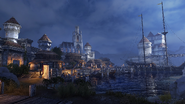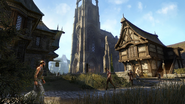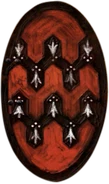- "The Gold Coast serves as a wonderful destination for travelers that seek the most interesting sights in Cyrodiil and enjoy the fine weather and sandy yellow beaches of Anvil. With bright sun and clear waves, the Gold Coast enjoys a pleasant climate fueled by warmer currents from the Abecean Sea. We offer a verdant paradise perfect for a hearty sort looking for true adventure on a reasonable budget."
- ―Astinia Isauricus[src]
The Gold Coast or the Strident Coast is the western savannah coast of the Colovian West, within the province of Cyrodiil. The Gold Coast takes its name from the lush, golden grasslands that stretch the coast from the Brena River to the Strid River. Most the settlements found in the land are farmlands, between the twin city-states of Kvatch and Anvil.
Description
Geography
Western Gold Coast
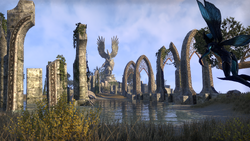
Garlas Malatar is an ancient city dedicated to Meridia, Daedric Prince of Infinite Energies.
The Western Gold Coast consists of the beaches of the region, which goes between the estuaries of both the Strid River and the Brena River. Most of the Gold Coast's activity comes from this area, as the city-state of Anvil is situated along the central bay. Underneath Anvil city is the Smuggler's Cave, where many Counts and Pirate Lords of Anvil have used as either their treasury or an escape route. The ruined Ayleid city of Garlas Malatar is found on the coast, on the outskirts of Anvil. It is also the westernmost Ayleid ruin in all of Cyrodiil. The majority of County Anvil is found along the coast, which continues into the Brena.
Eastern Gold Coast
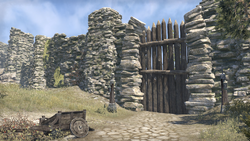
Varen's Wall was created to separate the Inner Gold Coast from the warring Imperial Province.
The Eastern Gold Coast is the central heartlands of the region, with the city-state of Kvatch nestled atop the hills overlooking the entire land. The Eastern area is heavily religious, with the Akatosh Chantry and the Order of the Hour having a strong presence in the area. Much of the land is primarily used in agriculture, specifically around the Kvatch outskirts. But the city of Kvatch is the main focal point, with the Kvatch Arena being the main attraction of the Eastern Gold Coast. The Dark Brotherhood also has a significant presence in the area, with two known sanctuaries in the area. The majority of County Kvatch is found in this region.
Outer Gold Coast
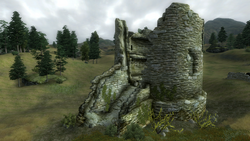
Fort Sutch was once a city-state of Cyrodiil, before falling into disrepair.
The Outer Gold Coast refers to the land outside of Varen's Wall, which was built amidst the Colovian Revolt during the Interregnum. While the wall is no longer present, it is still applicable to the area. This region is largely uninhabited, with the only settlement being the obscure city-state of Sutch, not far from the northern gatehouse. The ruins of Niryastare is the only other notable landmark in the region, but among them, are wildlands inhabited by Daedric Cultists at the Statue of Malacath, and various bandit encampments and redoubts moving northward. Most of County Sutch can be found here, but the scope is largely unknown.
Fauna
Dire Wolves
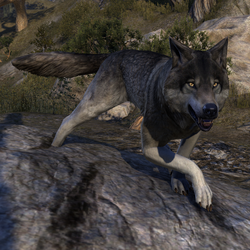
The Dire Wolves are represented in Kvatch's banner, and are common in the Abecean.
The Dire Wolves of the Gold Coast are a much stronger variant of the typical Wolf found throughout the continent. Depending on the region, the Dire Wolf do not live in packs; they are found in isolation because they are more than capable of hunting by themselves, and being ferocious when the time calls for it. Taming a Dire Wolf is much more difficult to do, considering their wild nature and independence, but the city-state of Kvatch has been known to breed such creatures as mounts or battle pets. If they are hungry enough, they will eat you, regardless of your companionship. They are also intelligent creatures, known for having a long memory. If it shows contempt, it is best to show respect and acknowledge it. They are predators by nature and can be stubborn. If they continue to hate, then just kill them. But do not do it around a mate, or they will hate you too, understandably.[1]
Goblins
The Goblins of the Gold Coast have an interesting history, in a story of alliances and a united group. As of 2E 583, there have been two main tribes, the Long Tooth Tribe, who claim the northern land near Knightsgrave and the ruins of Sutch, while the Sharp Stick Tribe, who claim the southern hills around the Strid River. Long ago, the Long Tooth consisted of three tribes, the Long Claws, the Tooth Rocks, and the Rock Sticks, the two formers were originally from the Colovian Highlands near Chorrol, warring against each other, but were driven out by the Fighters Guild and into the Gold Coast. It was here, the two tribes saw the Rock Sticks as a common enemy, and fought against the populous tribe. Eventually, the three tribes banded together as the Long Tooth, claiming northern Anvil County. The Sharp Stick is a mishmash of various tribes. The stories go as such: "The Eye Sticks fought the Sharp Rocks, who tricked the Shatter Bones into attacking the Blood Skulls. However, the mortal enemies of the Blood Skulls were the Gut Blades, who ambushed Shatter Bones and Blood Skull alike. When the Sharp Rocks and Eye Sticks saw the three-sided battle among rival tribes, they briefly allied to conquer the others." In one way or the other, the tribes became the Sharp Stick. It was considered only a matter of time before there was the hypothetical, "Long Stick Tribe".[2][3]
River Troll
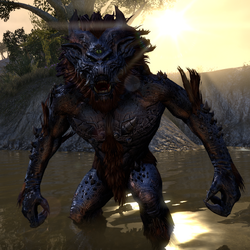
River Trolls are elusive, not recorded in the Imperial Register of Beasts and Lower Beings.
The Troll is a common creature throughout the provinces, albeit secluded in caves and isolated locations (i.e. a mountain pass or a clearing). There are several variants depending on the environment, such as the Frost Troll in the province of Skyrim, or the Swamp Troll in the deep region of the Nibenay Basin. But among these, the most obscure and elusive are the River Troll, which are found in the riverways of Cyrodiil, primarily the Niben River and the twin rivers of the Gold Coast. The River Troll are hunted in the city-state of Sutch, where their carcasses are considered valuable. They resemble the typical Troll, but their hide is silver-blue in color, with water-shedding scales. Their fangs and claws are designed to primarily hunt fish, as their hands have webbing and their teeth are razor sharp for even toughest of fish. Like other Trolls, they live in caves and hidden alcoves, but they eat things such as common river fish, to Mudcrab and even Crocodile.[3][4]
Nixad
The Nixad are mischievous humanoid incest that lives primarily in the Colovian West, originally living in the region of the Great Forest, before migrating into the Gold Coast. The Nixad is reminiscent of the Faerie, more specifically, the Pixies of Hammerfell. They live all throughout the savannah, in glades and meadows throughout the Coast. They take pleasure in other people's pain, known to laugh and mock those in obvious irritation. According to some folktales, the Nixad like to pluck the eyes of children and roll them in piles of Moon Sugar, to eat them. The only way to prevent this is to distract them, humiliating the possible victim. But despite their cruel nature, they can be loyal and friendly pets. A unique type of Nixad, the Orchid Nixad are revered by worshippers of Dibella, being found in places that worship the Goddess of Beauty, a place like the Chapel of Dibella in Anvil. Supposedly, Empress Tavia had an Orchid Nixad during her imprisonment at Castle Giovesse in the city-state of Gideon.[3][5]
Minotaur
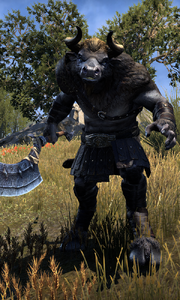
Minotaurs are a beastfolk that represent St. Alessia's time.
The Minotaur are a type of beastfolk found in the province of Cyrodiil, a common beastfolk in the Empire, albeit more tribal and aggressive than the Orsimer of the Greater Reach. The Minotaurs are also known as Man-Bulls, for they are half-men and half-bull. The most well-known Minotaur is Belharza, the son of St. Alessia, and the second Emperor of the First Empire. Minotaurs are large and hulking when compared to the Imperials of the First Empire. They were devouts of St. Alessia and had upheld this in some ways, even when they were shunned by the Alessian Order amidst their dysphoria, which was not exclusive to the Elves. Minotaurs in the Gold Coast live near ruins, but primarily the ruins of Knightsgrave, which is a mausoleum to the Order of the Hour, but it is a site of worship for Akatosh to the Alessian Empire. Minotaurs live in tribes throughout Cyrodiil, being driven out into the frontier of the Empire, with records of their role in society wiped by the malcontent. The Minotaurs have a unique type of armor, with aspects of a barbaric nature, but with nodes to the Alessian Empire, and their representation, in the form of Belharza and Morihaus. Even though they are shunned in modern-day society, the people of the modern age have recognized their once illustrious past in the early first era. Despite the abundance of male Minotaurs, there are, in fact, female Minotaurs.[3][6][7][8]
Miscellaneous Creatures
- Antelope
- Auroran
- Badger
- Bat
- Bullface Wingfin
- Daggerback
- Dark Guardian
- Dreugh
- Ghastly Batfish
- Heron
- Lynx
- Mountain Lion
- Palatine Sabertooth
- Seagull
- Skeleton
- Sleeper Shark
- Thunderbug
- Wispmother
Flora
Government
Religion
History
First Era
Amidst the Alessian Empire; the Nedic & Colovian Gold Coast
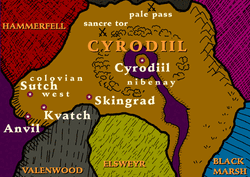
The Nedes had controlled the Gold Coast from Kvatch, but were thwarted by the Colovians.
- "The West is respected as Cyrodiil's iron hand: firm, unwavering, and ever-vigilant. The Cyro-Nords that settled it had relinquished the fertile Nibenay Valley long ago, determined to conquer the frontier. Their primitive ferocity was disinclined to magic or the need for industry, preferring bloody engagement and plunder instead. After they had captured the Nedic port-cities of the Strident coast, the Westerners embarked on a mastery of the sea."
- ―Imperial Geographic Society[src]
As many know, the Ayleids migrated to the modern-day province of Cyrodiil, where they expanded their Kingdom from the east and west, one of those settlements, was the city-state of Garlas Malatar, a temple-city dedicated to Meridia, the Daedric Prince of Infinite Energies. But in 1E 243, the Nedic slaves, under the command of Saint Alessia conquered their land and established the First Empire. Their people spread across the land, amidst their conquest, the modern-day cities of Cyrodiil were founded. In the Gold Coast, the Nedes built towns all across the Western Gold Coast, which could have very well led to the creation of Anvil. The Nedic Kingdom of the Strident Coast had ruled out of the city-state of Kvatch, where the entire land was governed by three lords, one of them being the King. This continued for several years until the arrival of the Colovians, Imperial Westerners who hail from the city-states of Skingrad and Chorrol. The Colovians had overwhelmed the Strident Nedes and took over their land, thus bringing the Gold Coast into the Colovian Estates and exploring the unconquered waters of the Abecean Sea. The Estates are an autonomous government which consists of West Cyrodiil and nations along the outer border such as Arenthia and Elinhir. To this day, Kvatch has been a juggernaut amidst the Colovian Estates, forming a strong rivalry with the Kingdom of Skingrad in the east. With their land gone, the Nedes retreated to the north, in the wastes of modern-day Hammerfell, founding the grand city-state of Skyreach.[9][10][11]
Tale of Nunex Faleria & Tribune's Folly
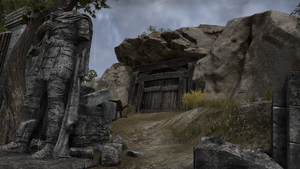
The excavated ruins of Fort Faleria, now known as, Tribune's Folly was Lord Faleria's legacy.
- "Legend has it that in the early days of Cyrodiil, in the wake of the Alessian Doctrines, there were three lords that formed a regency council over the Kingdom of Kvatch. The name of that king and two of the lords are lost to history. Lord Faleria's name, however, is whispered in the night as a cautionary tale of how far one would go to protect those they love."
- ―Anonymous[src]
During the time of the Nedes, Nunex Faleria was one of the three lords of the Kingdom of Kvatch sometime around the foundation of the Alessian Order, circa 1E 361, around the reign of Emperor Ami-El. Nunex Faleria, much to the dismay of his family, fell in love with an Ayleid scholar, hailing from the city-state of Nenalata and having proficiency in Necromancy and Dark Magic. Despite Nenalata having sworn allegiance to the Alessian Empire, they were unwelcome in their society. To hide her from an inevitable purge, Lord Nunex commissioned the construction of Fort Faleria, an underground complex met to house them till their last days. The Fort was built by the combined forces of magic, hired workers, and various Minotaur tribes. Eventually, Fort Faleria was finished, and Lord Faleria's family lived in the underground castle for many years.[10][OOG 1]
However, as time went on, Lord Faleria became paranoid, dabbling in evil magic. After the birth of their third child, Lady Faleria was dead, leaving Lord Nunex descending into madness. Prompting his children to desire escape into the outside world. One fateful day, Nunex's son escaped the fort and fell in love with a merchant lord's daughter, who would eventually learn of his heritage. Ultimately, the Alessian Empire were on castle doorstep, seeking to purge the region of their existence. Out of desperation, Lord Nunex buried the entire fortress entirely underground, killing and trapping everyone inside. To this day, Fort Faleria was lost to time, and legends surrounding it spread like wildfire. His entire lineage was buried in Fort Faleria that day, never to see the light of day. But in 2E 583, Fort Faleria was excavated by the Gold Coast Trading Company and renamed into Tribune's Folly.[10]
Rislav the Righteous & the War of Righteousness
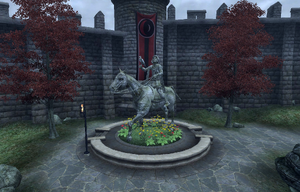
Rislav Larich inspired revolution against the Alessian Empire across Tamriel, beginning from Kvatch.
- "Children of kings are, of course, married to the children of other kings to bind alliances. The kingdoms of Skingrad and Kvatch skirmished over common territory throughout the fifth century, until they reached a peace in the year 472. The details of this accord are not recorded, but since we know that Prince Rislav was in the court of Kvatch six years later, as husband to Belene, the daughter of King Justinius, it is fair to make an educated guess that they were married then to make peace."
- ―Sinjin[src]
The Kingdoms of Colovia co-existed with one another, as the Alessian Empire prospered throughout the realms. The First Empire had been founded in the early first era, and are well deep in the fifth century under the reign of Gorieus. The Colovian Estates have been under the rule of the Alessians but have worked as the autonomous government of the Estates. By 1E 472, the Kingdoms of Skingrad and Kvatch held skirmishes for common territory until they reconciled when Rislav Larich and Belene married sometime later around 1E 478. Rislav was a member of the Court of Kvatch and was in close talk with King Justinius, the then leader of Kvatch. But things would change in the same year when an unknown plague swept across the Colovian West and killed practically all of Rislav's seven older siblings save for one, Dorald Larich.[12]
Dorald, being a priest of the Alessian Order, claimed his birthright and brought the Kingdom of Skingrad into the Alessian Empire. This decision had left the people of Colovia in utter shock and rage, especially Rislav, who sought to take Skingrad by force. With his father-in-law's militia, Rislav Larich claimed Skingrad and slain his older brother. What came after was years of conflict that led many to rebel against the Alessian Order, as seen with the Battle of Sungard in Skyrim and the Battle of Glenumbria Moors in High Rock. It began with Skingrad and Kvatch, but soon, Anvil, Chorrol, and the rest of the Northwest World fought the Alessian Empire, as it was told in the legend of Rislav the Righteous. This was the beginning of the fall of the First Empire.[12]
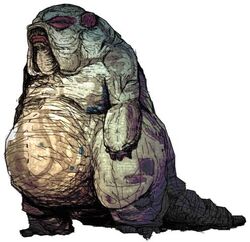
The Sload of Thras unleashed their plague across Tamriel, prompting Tamriel to fight back.
- "Things persisted in this vein until the Thrassian Plague of 1E 2200, which decimated more than half of Tamriel's population, particularly the western coastlands closest to Thras. After Bendu Olo, the Colovian king of Anvil, led the All Flags Navy to victory over the slugfolk of Thras, the glory of the Cyrodilic people became known throughout the world."
- ―Imperial Geographic Society[src]
In 1E 2200, the Sload of Thras had unleashed a horrifying plague called the Thrassian Plague throughout the Western World. Symptoms of the plague include an intense thirst that is unquenchable. The people would drink and drink until their bones are cracked, and their flesh was bulging. The Plague spread all over the continent, and of their most notable victims was the city-state that became Corgrad Wastes and the drastic decrease in population for the Iliac Bay. When the people had reached their breaking point, Bendu Olo, the King of Anvil amassed a force unlike which the provinces would not witness for many years. Bendu Olo created the All Flags Navy, primarily from the Kings and Barons of the Western World, from Summerset Isles, to Hammerfell, and even from far away Black Marsh. Bendu Olo sailed from Anvil to the archipelago of Thras and sacked the Coral Tower, subsequently sinking Thras into the Sea of Pearls. Many notable figures aided Baron-Admiral Olo in battle, such as Baron-Captain Olsien Guy Mard of Evermore, Captain Tsona-Ei of Alten Corimont, and Syrabane, Altmeri Warlock who became a part of the Aldmeri Pantheon ever since. When Bendu Olo returned to Anvil, he was proclaimed a hero, and the fortress built outside the harbor town was converted into Castle Anvil. The events that transpired had the realms of Colovia overshadow the Nibenay in the east, which would then bring about the War of Righteousness in the late first era. This would eventually bring about the end of the Alessian Empire, with the raze of the Order's monastery at Lake Canulus.[9][13][14][15][16][OOG 2]
Second Era
The Longhouse Emperors & Varen's Wall
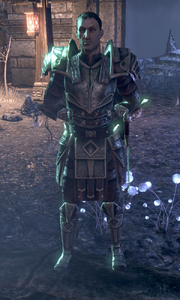
Varen Aquilarios sealed the Gold Coast to protect it from Leovic.
- "Shortly after the start of Varen's Rebellion, Aquilarios ordered his followers to begin construction of a wall to protect Kvatch and the rest of the Gold Coast from retaliation by the Longhouse Emperor and his troops. Aquilarios, determined to take the battle to the heart of the Empire, didn't want to leave his home and original seat of power open to retribution by his enemies in his absence."
- ―Midara Salviticus[src]
Ever since the death of Reman Cyrodiil III in 1E 2920, the Ruby Throne of the Imperial City had been left unclaimed, sparking a several hundred year-long period known as the Interregnum. Many different warriors and nobles, all over the continent set forth to claim the Imperial City and rule over the province. At one point, the Reachmen Warlord, Durcorach the Black Drake took control of the Imperial City, establishing a short-lived dynasty known as the Longhouse Emperors, which continued with Emperor Leovic, Durcorach's grandson. The reign of the Longhouse has been controversial, to say the least, but when Leovic legalized Daedric worship in Cyrodiil, this sparked revolution. Varen Aquilarios, Duke of Chorrol, and son of Kvatch raised an army with the Colovian Estates, which became known as the Colovian Revolt. To protect his home, the Gold Coast from Leovic's forces, he hastily constructed Varen's Wall, a stone wall that separates the region from the Colovian Highlands and the outskirts of the Gold Coast. By 2E 577, Varen Aquilarios became the Emperor of Tamriel and married Clivia Tharn. Between Varen's declaration of revolution and his disappearance in 2E 578, the Gold Coast makes drastic changes that separated itself from the rest of Cyrodiil.[17][18]
The Wolf of Kvatch; Carolus Aquilarios
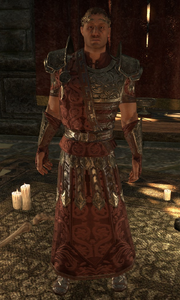
Carolus Aquilarios inherited Kvatch from his uncle, Varen.
- "Carolus Aquilarios idolized his uncle and was eager to help when Varen declared open rebellion against the Emperor. In fact, Carolus wanted to join Varen and fight alongside him as he marched toward the Imperial City. But Varen had other plans for Carolus. He wanted someone he could trust to protect the homefront - someone like his honorable nephew."
- ―Midara Salviticus[src]
Varen Aquilarios hails from the city-state of Kvatch and holds the entirety of the Gold Coast dearly, and so, he sought to protect his home from Emperor Leovic, but he needed a worthy leader for the position. His nephew, Carolus Aquilarios was chosen by him to take the helm of Count of Kvatch, despite yearning to fight alongside his uncle, Carolus vowed to watch over the Gold Coast, till his dying breath. But with the Gold Coast barred from the rest of the province, political conflict arose, specifically from Anvil. Count Ephrem Benirus, and the Imperial Prefect of Anvil, amassed a militia to take control over Carolus' holdings. But with the Kvatch Warders and a cohort of the Second Legion, Count Aquilarios had overwhelmed Count Benirus. This had continued for many years as Benirus' forces dwindled, but until Varen Aquilarios assumed the throne as Emperor. For his loyalty and perseverance, Carolus was officially named the Count of Kvatch, and earned the name of the "Wolf of Kvatch". But as Count Carolus was fully-established as the leader, another group had risen into power, trifling over the Court of Kvatch, operating out of the Cathedral of Akatosh.[19]
The Order of the Hour; Enforcers of the Chief Deity

The Order of the Hour are the militant arm of the Akatosh Chantry as of many years.
- "The Order of the Hour is one of the oldest knightly orders in the Empire. It was born early in the life of the Empire, during the First Era, and eventually faded into obscurity during the Second Era. It was founded by Ennon Decan as an order of knights dedicated to Akatosh, though originally it drew its members from the priesthood and military alike."
- ―Exordor Vasidius[src]
The Akatosh Chantry has been the main religious group of Akatosh, recognized as far as the Iliac Bay, in places such as Wayrest and Bergama. But like the other specific temples, the Chantry has a militant arm, in the form of the Order of the Hour. The group was founded in the early years of the first era, likely inspired by St. Alessia and her divine gift from Akatosh. The Order had faded away in time, but it was revived in 2E 432, with the city-state of Kvatch, in response to the growing power of the Longhouse Emperors. Fearing a great purge of worship over the Eight Divines, Cavor Merula created the Order of the Hour, consisting of those undyingly devoted to Akatosh. Fortunately for them, the purge against the Divines had never come, but the Order had evolved from a rag-tag group of soldiers and priest to an elite militia of bodyguards to the Primate of the Akatosh Chantry. The Order remained in the shadows until a threat would appear on their doorstep. This had ranged to the Kvatch Bread Riots in 2E 467, when the Order under Sister Severa had slaughtered rioters prepared to burn down the cathedral, for lack of divine aid. When in 2E 480, a group of Orcish Berserkers had attacked Kvatch, Count Varen, and the Order fought against them, with the Order merely doing it protect the Cathedral. As of 2E 582, the newly-named Primate, Artorius Ponticus had elevated the role of the Order in Kvatch, threatening the power that Count Carolus had acquired.[20]
The Pirate Queen of the Gold Coast & the Red Sails

Captain Fortunata ap Dugal and the Red Sails conquered Anvil.
- "When the time was right, Fortunata and her armada sailed into Anvil Harbor and grabbed control of the city. Now Provincial Governor Fortunata and her Red Sails enforcers claim the entire Gold Coast as their personal domain. It's estimated that the Red Sails have more than two dozen vessels under the blood-red sabers on a white banner. A navy in its own right, the Pirate Queen could lay claim to any port she desired."
- ―Anonymous[src]
Count Ephrem Benirus continued his rule over Anvil, even after his failed attempt at claiming Kvatch from Carolus Aquilarios. But his time as the Count would end shortly. A group known as the Red Sails had appeared throughout the Abecean Sea, under the command of Fortunata ap Dugal. Originally a band of pirates in the Strid River, the Red Sails had evolved with ap Dugal's involvement, mainly due to her position in the Gold Coast Trading Company. As time went on, Fortunata had expanded her armada, becoming a public threat across the Abecean waters, but she desired more power. In 2E 577, the Red Sails landed on the Anvil Harbor, overwhelming the remaining soldiers of the Imperial Prefect. In no time flat, Fortunata ap Dugal had conquered the city-state of Anvil and proclaimed herself as the Provincial Governor. With this, the Gold Coast Trading Company expanded their horizons and became a leading force, alongside the Dragonstar Caravan Company. The Pirate Lords and Buccaneers of the Red Sails became merchant lords and ship captains of a much greater army. Fortunata's reign over Anvil was held together by an iron fist, putting her crew first over the people. Many considered Anvil to be the first step, as she plans to take over Kvatch in the east. Without the Imperial Navy, and by that extent, the Imperial Legion to fight against her, it was considered only a matter of time before she took over the entire Gold Coast.[21][22]
The Independent Gold Coast & the Strident Triumvirate
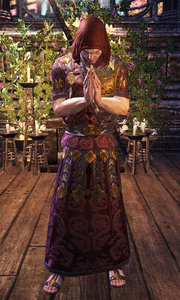
Primate Artorius Ponticus is the leader of the Order of the Hour.
- "Now, Her Eminence knows all about your objections to the fact that she has annexed the entire Gold Coast and placed everything southwest of Varen's Wall under her protection. She has done this because she cares and because she has the means and resources to fulfill her promise to the people of the Gold Coast. Why can't you just accept her generosity and stop this continuous bickering?"
- ―Braccus Klinicus, Master Scribe of Anvil Castle[src]
Fortunata ap Dugal's ambitions would soon take action, as she begins her attempt to take over Kvatch. Amidst her rise to power, Fortunata ap Dugal had declared the Gold Coast as an independent state from the rest of Cyrodiil in 2E 579, when the Soulburst occurred and the Imperial City was in more shambles, as the Daedric Hordes from Coldharbour, under the command of Molag Bal took over Central Cyrodiil, and the Empire under Clivia Tharn, Empress-Regent. The Gold Coast, despite under the command of a Pirate Queen, had prospered amidst the destruction of the heartland. Governor Fortunata had pressed Kvatch to join her diplomatically, albeit underhanded as time went. Count Carolus Aquilarios had denied her advances, every single time, and so the Red Sails would passive-aggressively harass Kvatch, by disrupting the trade flow on the Gold Road. Feeling threatened, Count Carolus had sent the Kvatch Warders on the outskirts of Kvatch, to confront the Red Sails. Both groups had met each other outside Gottshaw Inn. The Warders quickly defeated the motley crew of Anvil warriors, until a raging horde of pirates surrounded them. This event was known as the Gottshaw Massacre, as the pirates outnumbered the legion, six to one. To prevent war, Count Carolus had sworn loyalty to Anvil, losing significant rule. All the while, the Order of the Hour, under the command of Primate Artorius Ponticus, had risen, threatening the Court of Kvatch's power in their own city. Amidst the Independent region of the Gold Coast, was a triumvirate of rulers, Count Carolus Aquilarios of Kvatch, Governor Fortunata ap Dugal, and Primate Artorius. This would continue, even into the Alliance War, to which the Gold Coast was neutral.[20][23][OOG 3]
Voices in the Dark; Enter the Dark Brotherhood
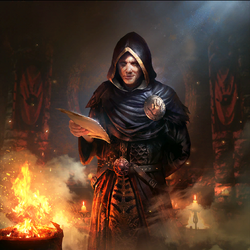
Speaker Terenus was the leader of the Gold Coast Dark Brotherhood, in the Eastern area.
- "The people of Kvatch were renowned for their piety, and it was said the Primate of Akatosh was almost the city’s co-ruler. Which would make it a perfect place for a chapter of the Dark Brotherhood, as assassins-for-hire do their best business where regulations are strict and people feel constrained and inhibited. With no way to vent frustrations, minor disagreements become major conflicts, and sometimes a person’s removal seems like the only solution."
- ―Naryu Virian[src]
The Dark Brotherhood has had a presence in the Gold Coast for quite some time, with one of their oldest sanctuaries, the Erstwhile Sanctuary being found in the hills of Kvatch, built into the city's foundation. It was abandoned when the wall in the Speaker's bedchamber collapsed and revealed an ancient cavern. As of 2E 583, the Gold Coast Sanctuary found beyond the Gold Road, was under the administration of Astara Caerellius, the Matron of the Sanctuary. The Black Hand member, Speaker Terenus had also operated here. Amidst the growing conflict, business for the Dark Brotherhood had been booming. Their presence had soon become established with the death of Lord Quintus Jarol, an Imperial nobleman who lived in the north from Anvil. Lord Jarol had orchestrated meetings between the Strident Triumvirate at his home, to successfully negotiate a United Gold Coast. When he caught wind of the Brotherhood's assassin, Lord Jarol attempted to escape via a tunnel underneath his estate. Unfortunately, Lord Quintus Jarol was found dead in the harbor of his home, catching the attention of the entire Gold Coast. The Dark Brotherhood had become well-known throughout the region, irritating the Order of the Hour in particular.[24][25][26]
The Order vs. the Brotherhood; The Fall of the Red Sail

Grand Sermonizer Fithia at-Himah was murdered by the Brotherhood for meddling against them.
- "Murder is a filthy business in the eyes of Akatosh. And those who treat murder as business are the worst of all! Hear me, faithful of Akatosh. I speak of the foul followers of Sithis: the Dark Brotherhood! Cowards and skeever-lovers, the lot of them."
- ―Akatosh Sermonizer[src]
When news of Lord Jarol's death had sprung across the Gold Coast, Akatosh Sermonizers took the streets of Kvatch, in the attempt to slander their name, and perhaps root them out of their sanctuary. The chief orchestrator in this was Grand Sermonizer, Fithia at-Himah, a noblewoman of Kvatch. The Order had also sought the help of a warrior, known only as the Black Dragon, a woman who was lost until the divine hand of Akatosh showed her the way. Sometime later, the Order had captured a Dark Brotherhood assassin, a Redguard named Cimbar, torturing him for information to no avail. Moments later, Grand Sermonizer Fithia was killed by the Dark Brotherhood, in an Ayleid sanctum underneath her home. Another soul was taken to the Void. And so the war against the Order and the Brotherhood had started, with each of their numbers dwindling by the day.[27]
With this news, both Governor Fortunata ap Dugal and Count Carolus Aquilarios sought their help in the battle against the Order of the Hour. However, only one these people would make it out. The Dark Brotherhood was contacted by the Governor to eliminate Marcus Scipio, leading Commander of the Order. The knightly order had established a stronghold outside Kvatch, the Enclave of the Hourglass. And so, the Anvilian Governor sought to take him out, to prevent any movement onto County Anvil. But lo and behold, after the Imperial Commander was killed in Castle Kvatch, the Count himself had performed the Black Sacrament, calling for the death of the Governor. This proved to be a win-win situation for the Count, as it not only weakened control over the Order, but it meant the downfall of the Red Sails and their control over Anvil. In the end, two Brotherhood assassins, one of them being Mirabelle Motierre, poisoned the Governor, who then fell to her doom on the rocky shores of the Castle. The Red Sails fragmented, and the Count looked to the Brotherhood as allies, in their common goal against the Order.[28]
The Order vs the Brotherhood; The Primate's Folly
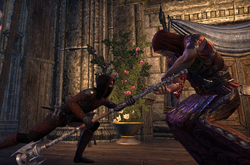
Primate Artorius was killed in a raid by the Brotherhood, near several dead bodies.
- "The Black Hand has studied the situation and we have devised a strategy for dealing with the Order of the Hour. We will strike first, attacking from the shadows and winnowing their numbers while you stalk our true enemy—Primate Artorius."
- ―Speaker Terenus[src]
More and more agents of the Order and the Brotherhood had perished, as more contracts had been made, and the Black Dragon hunted the assassins of the Coast. Eventually, the Dark Brotherhood had caught up with the Order of the Hour, ever since the death of the Black Dragon, deep within the ancient mausoleum of Knightsgrave, built during the Alessian Empire. It served as a burial ground for the Order of the Hour. It was in the deepest chamber; the Black Dragon was killed by a Wrath of Sithis, who take the lives of those who have forsaken the Five Tenets of the Dark Brotherhood. With the main enforcer dealt with, the Dark Brotherhood had targeted Primate Artorius, who had sealed the Cathedral of Akatosh. Via a forgotten tunnel, the Brotherhood had massacred various Order knights and dueled the Primate. In the end, the Primate was killed by a talented assassin, who pierced the Primate's staff into Artorius' abdomen. The Primate of the Akatosh Chantry had died, amidst various bodies. With both the Red Sails and the Order out of the way, Count Carolus continued his reign over the Gold Coast, as his uncle had intended. The Gold Coast had prospered amidst the war-torn province of Cyrodiil.[29][30]
Third Era
Terror of the Gold Coast; Enter Torradan ap Dugal
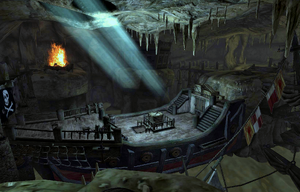
The Wreck of the Black Flag, Torradan ap Dugal's ship in Dunbarrow Cove, underneath Castle Anvil.
- "I curse the day that the Cameron Usurper died at that war ended, 'cause it was that day that Commodore Fasil Umbranox turned 'is attention to the Red Sabre. A couple of months after the war, that fat pompuss bastard decided to come down here to Anvil and take up port in my town, lookin' to break up the Red Sabre. The Emporer gave him whatev'r he asked for to campaign again' us, despite the coffers bein' empty from the war in High Rock."
- ―Torradan ap Dugal[src]
In 3E 246, Haymon Camoran, the recent usurper of the Camoran Dynasty had invaded Western Tamriel, under the name of the Camoran Usurper. The Usurper's army had started from the city-state of Arenthia, and moving north along the Abecean Coast and eventually the Iliac Bay. Before the Usurper had reached the province of Hammerfell, he had sacked the city-state of Kvatch, paving the way for the Battle of Dragontooth and the fall of the twin cities of Rihad and Taneth. With the Usurper occupying the Imperial Navy, Pirates of the Abecean Sea took this time to attack lands along the Abecean Sea. Pirate activity had increased tenfold in Anvil. The Pirate Captain, Kaladas, had died in Anvil Harbortown from a fatal night of drinking. Amidst the conflict, the pirate, Torradan ap Dugal had risen to prominence, as the captain of the Red Sabres. With the Navy in need of supplies to High Rock, Torradan would intercept these ships and build a vast armada from Valenwood to Hammerfell. Torradan ap Dugal took control over Anvil, as the Empire was focused elsewhere.[31][32][33]
But this would end in 3E 267 when the Camoran Usurper died at the Battle of Firewaves in the Iliac Bay. Fasil Umbranox, Imperial Commodore of the Imperial Navy had set his attention to ap Dugal and landed on the harbor of Anvil. After a grueling battle, Anvil was captured by Fasil Umbranox, who began a hunt for the Black Flag, Torradan's ship. But when Torradan had evaded him and returned to Anvil, his ship was attacked by warriors waiting on the port. In the end, it was only Torradan's Black Flag and Umbranox's ship. As Torradan attempted to escape, the Commodore's mages plunged him into the depths of Anvil Bay, where he was stuck in Smuggler's Cave. Eventually, Torradan died after twenty years of being trapped. His ship has remained underneath Castle Anvil since. For his valor, Fasil Umbranox became the Count of Anvil, with his lineage ruling ever since.[34][35]
The Counts of the Coast & the Waning Third Era
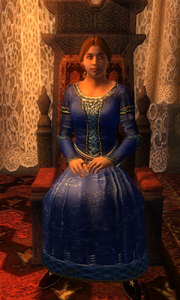
Millona Umbranox took over Anvil after her husband, Corvus.
- "The ruler of Anvil is Countess Millona Umbranox. Her husband, Corvus Umbranox, disappeared many years ago, and most persons would agree that Her Ladyship is better off without him, for he was a light and frivolous person, and given to loose and riotous behavior likely to promote scandal. The Countess herself is a righteous and godly woman, and an excellent ruler, well-loved by the people."
- ―Alessia Ottus[src]
Ever since the Imperial Simulacrum after 3E 399, the province of Cyrodiil had been in peace, amidst the waning years of the reign of Uriel Septim VII, who has ruled over Tamriel since 3E 368. Along though conflict has sprung up in the Empire, specifically in the north, Tamriel has been in at ease and in preparation for great things. Although minor things have been reported, with some noteworthy in the Gold Coast. In 3E 423, the Count of Anvil, Corvus Umbranox was named the Guildmaster of the Thieves Guild, donning the Gray Cowl of Nocturnal, which has been passed down from each Cyrodiil Guildmaster since the original, Emer Dareloth. Corvus had donned the cowl but took upon Nocturnal's curse, whoever wore it would be removed from history. From then on, Corvus was gone, and Countess Millona Umbranox had assumed the role of leader of Anvil, for ten years, and into the Fourth Era. But all the while, the Count of Kvatch, Ormellius Goldwine had other problems. His sons, both sought to inherit the title of Count from their father until they both had lost their lives amidst the family strife. Stricken with grief, Count Goldwine continued his reign over Kvatch, all the while mourning the loss of his sons. A new heir had to be chosen, but all in due time. In the Imperial City, Uriel Septim VII would pass his throne to his eldest son, Geldall Septim, Crown Prince of the Empire.[36][37]
The Oblivion Crisis & the Battle of Kvatch
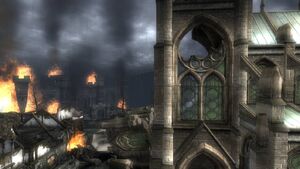
The city-state of Kvatch was a casualty in the Oblivion Crisis, the first in the province of Cyrodiil.
- "Gods' blood, you don't know, do you? Daedra overran Kvatch last night! There were glowing portals outside the walls! Gates to Oblivion itself! There was a huge creature... something out of a nightmare... came right over the walls... blasting fire. They swarmed around it... killing... Go and see for yourself! Kvatch is a smoking ruin! We're all that's left, do you understand me? Everyone else is dead!"
- ―Hirtel[src]
In 3E 433, Emperor Uriel Septim VII was killed by assassins of the Mythic Dawn, after all of his sons were murdered prior. With no other heir, the Dragonfires were unlit and the barrier between Nirn and Oblivion was gone. Mehrunes Dagon and his Oblivion Horde had invaded the continent of Tamriel in the event known as the Oblivion Crisis. All throughout the continent, Oblivion Gates had opened, leading to the fall of notable locations such as the city-state of Ald'ruhn in Morrowind and the Crystal Tower in the Summerset Isles. But the biggest driving point in the Crisis was the Battle of Kvatch, which took place at the aforementioned city-state of Kvatch. An Oblivion Gate had in front of the city gates, to which the horde had swarmed the entire city, causing the chapel to collapse onto the main street.[38][39][40][41]
Count Ormellius Goldwine and the Kvatch Guard at the castle were killed, with the entire hall set ablaze. Brother Martin, a priest of Akatosh was able to keep a group of people inside the chapel, away from the Daedra. Amidst the conflict, Saint Jiub of Vvardenfell was killed. Savlian Matius, Captain of the City Guard had held the Daedra back from the outer gate, safeguarding the refugee camp. When all hope seemed lost, a traveler came and closed the Oblivion Gate. With the help of the city guard and rangers of the Imperial Legion, the Daedric Horde was defeated and Kvatch was freed. But the city remained in ruins. The remaining guard and Savlian took refuge in the Castle. The Crisis was over when Mehrunes Dagon was cast into Oblivion and Martin Septim sacrificed himself to banish him. Chancellor Ocato, had declared the end of the third era, as the Septim Dynasty had officially died. The Empire of Tamriel continued into the Fourth Era.[41][42][43]
The Auroran Crisis & Desecration at Anvil Temple
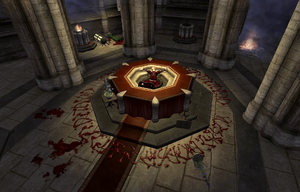
The Chapel of Dibella was desecrated by followers of Umaril the Unfeathered, marking his arrival.
- "Hear me, o people of Cyrodiil! Look well upon the Chapel of Dibella. Look at the faces of the dead. This is your future. Evil has returned, and the Nine need a champion! Is there no one who would stand for the Nine? Now Mara's children cry out from beyond the grave for vengeance! How many more must die at Umaril's hand?"
- ―The Prophet[src]
Around this time, tragedy struck the city-state of Anvil when the Chapel of Dibella was desecrated by an unknown group, indicating the return of Umaril the Unfeathered, the Sorcerer-King of the Ayleids, before the Alessian Slave Rebellion and his death at the hands of Pelinal Whitestrake. Whitestrake had killed Umaril at the Imperial City, but because of his allegiance with Meridia, the Daedric Prince of Infinite Energies, he was immortal. When he was killed, his spiritual form had left for Aetherius, waiting for the time to return and seek vengeance on the Divines. When word of the incident in Anvil had spread, a warrior had sought forth to gather the relics of the Divine Crusader and reform the Knights of the Nine. As time went on, the warrior gathered a motley crew of warriors and fully-acquiring all of the relics. With everything ready, the Knights of the Nine gathered the forces at Umaril's stronghold, the ruined city-state of Garlas Malatar. As the Knights battled through waves of Aurorans, the Divine Crusader and Umaril confronted each other, dueling to the death. But with Umaril's physical body destroyed, only his spiritual body remained. The two were taken to the skies beyond the Imperial City, where Umaril was ultimately defeated. The Knights of the Nine had continued their sworn duty of serving the Nine Divines.[44][45][46]
Fourth Era
The Westward Front & the Cyrodiil Campaign
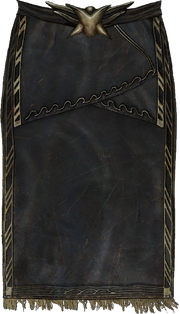
The Aldmeri Dominion moved across Colovia and the Alik'r.
- "At the same time, an Aldmeri army under Lady Arannelya crossed into western Cyrodiil from Valenwood, bypassing Anvil and Kvatch and crossing into Hammerfell. Smaller Aldmeri forces landed along the southern coastline of Hammerfell. The disunited Redguard forces offered only scattered resistance to the invaders, and much of the southern coastline was quickly overrun. The greatly outnumbered Imperial legions retreated across the Alik'r Desert in the now-famous March of Thirst."
- ―Justianus Quintius
On the 30th of Frostfall, 4E 171, the Third Aldmeri Dominion waged war with the Third Empire of Cyrodiil, under the reign of Titus Mede II. The westward campaign of the Dominion was under the control of Lady Arannelya, who moved from Valenwood, through the Gold Coast and eventually the province of Hammerfell. The city-states of Anvil and Kvatch were saved from the Dominion's Wrath, but eventually, the Aldmeri Dominion was en route to the Imperial City, as of 4E 172. Initially, the Dominion sought to claim the southern regions of Hammerfell, but because of Lord Naarifin's success on the eastward front in the Nibenay, the Dominion had set their sights on the Imperial City. The conflict in Cyrodiil had begun with the destruction of both Anvil and Bravil, and by the end of the year, Lord Naarifin's army was on the outer walls of the Imperial City. The Dominion's reign over the Imperial City had lasted for a couple years, until Titus Mede II himself, wielding Goldbrand retook the city at the Battle of the Red Ring in 4E 175. The province of Cyrodiil was saved from the onslaught of the Dominion, but to prevent further war, the Empire and the Thalmor created the White-Gold Concordat, a controversial treaty that shifts the tides of Tamriel for many years. Anvil was rebuilt amidst the peace.[47]
Locations
Regions
Settlements
- Anvil
- Kvatch
- Castle Kvatch
- Chapel of Akatosh
- The Eight Blessings
- Trader's Circle
- Kvatch Arena
- Sutch
- At-Himah Family Estate
- Brina Cross Inn
- Enclave of the Hourglass
- Gold Coast Sanctuary
- Gottshaw Inn
- Gweden Farm
- Jarol Estate
- Lord Drad's Estate
- Marja's Mill
- Shetcombe Farm
- Strid River Artisans Camp
- The Withered Rose
- Whitmond Farm
Ruins
- Beldaburo
- Colovian Revolt Forge Yard
- Crowhaven
- Dasek Moor
- Erstwhile Sanctuary
- Fort Linchal
- Fort Strand
- Garlas Agea
- Garlas Malatar
- Knightsgrave
- Niryastare
- Tribune's Folly
- Trumbe
Caves
Landmarks
- Abecean Sea
- Anvil Bay
- Brena River
- Dragon's Teeth Mountains
- Gold Road
- Malacath's Shrine
- Strid River
- Varen's Wall
- Varen's Wall Gatehouse (East)
Gallery
Appearances
- The Elder Scrolls Adventures: Redguard (mentioned only)
- The Elder Scrolls IV: Oblivion
- The Elder Scrolls V: Skyrim (mentioned only)
- The Elder Scrolls Online (mentioned only)
References
- ↑ Guide to Taming Dire Wolves
- ↑ Gold Coast Goblin Tribes
- ↑ 3.0 3.1 3.2 3.3 A Gold Coast Children's Bestiary
- ↑ Field Guide to River Trolls
- ↑ A Nixad Made Me Do It
- ↑ On Minotaurs
- ↑ Crafting Motif 39: Minotaur Style
- ↑ Brenus Astis' Journal
- ↑ 9.0 9.1 Pocket Guide to the Empire, First Edition: Cyrodiil
- ↑ 10.0 10.1 10.2 The Lost Fort Faleria
- ↑ Skyreach Explorer, Volume One
- ↑ 12.0 12.1 Rislav the Righteous
- ↑ The Royal House of King Eamond
- ↑ Journal of Tsona-Ei, Part One
- ↑ Varieties of Faith: The High Elves
- ↑ The Cleansing of the Fane
- ↑ Chronicles of the Five Companions 1
- ↑ Varen's Wall
- ↑ The Wolf and the Dragon
- ↑ 20.0 20.1 Order of the Hour
- ↑ Rise of the Red Sails
- ↑ Pirate Queen of the Gold Coast
- ↑ The Wolf and the Pirate Queen
- ↑ The Erstwhile Sanctuary Loading Screen
- ↑ Letter from the Governor
- ↑ Events of "Signed in Blood"
- ↑ Events of "A Lesson in Silence"
- ↑ Events of "A Special Request"
- ↑ Events of "The Wrath of Sithis"
- ↑ Events of "Filling the Void"
- ↑ The Refugees
- ↑ Cap'n Dugal's Journal, Book I
- ↑ Cap'n Dugal's Journal, Book II
- ↑ Cap'n Dugal's Journal, Book III
- ↑ Cap'n Dugal's Journal, Book IV
- ↑ Pocket Guide to the Empire, Third Edition: Cyrodiil
- ↑ Dialogue from "The Gray Fox"
- ↑ Events of "Tutorial"
- ↑ The Fall of Ald'Ruhn
- ↑ Rising Threat, Vol. I
- ↑ 41.0 41.1 Events of "Breaking the Siege of Kvatch"
- ↑ Events of "The Battle for Castle Kvatch"
- ↑ Events of "Light the Dragonfires"
- ↑ Events of "Pilgrimage"
- ↑ Events of "Umaril the Unfeathered"
- ↑ Dialogue from Pelinal Whitestrake
- ↑ The Great War
| Cyrodiil Locations in Lore | |
|---|---|
| Cities | Anvil • Bravil • Bruma • Cheydinhal • Chorrol • Imperial City • Kvatch • Leyawiin • Skingrad |
| Regions | Blackwood • Colovian Highlands • Gold Coast • Great Forest • Heartlands (City Isle) • Jerall Mountains • Nibenay Basin • Nibenay Valley • Valus Mountains • West Weald |
| Landmarks | Abagarlas • Arcane University • Cloud Ruler Temple • Delodiil • Garlas Malatar • Imperial Reserve • Lake Rumare • Niben Bay • Pale Pass • Priory of the Nine • Sancre Tor • Sutch • Temple of the One • Weynon Priory • White-Gold Tower |



